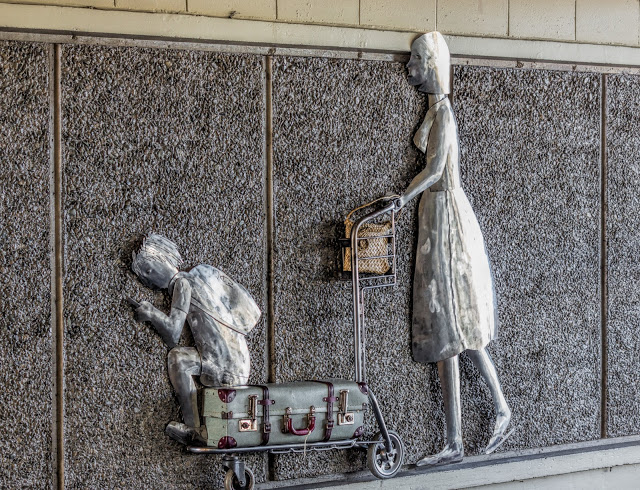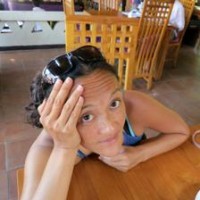I was born to travel.
My mother was an air hostess with KLM, Royal Dutch Airlines, so I was flying around the world before I was even breathing. The globetrotting continued throughout my childhood, as my father’s expat job made us move from country to country. And from each new location, we would visit other destinations, never spending a single holiday at “home”. By the age of eight, I was travelling alone, often flying to The Netherlands to visit grand-parents and friends.
The travelling has never stopped.
Fortunately, I do not only enjoy the time I spend at each destination, but I also take pleasure in the actual journey. I like the buzz at airports and the chaos at train stations. It’s fun to observe other passengers and fantasise about the reason for their voyage.
Never was I unable to sleep in moving vehicles, finding the sound of the engines soothing, the rhythmic swaying rocking me to sleep. Being rather short, I have always been able to fold myself up and get comfortable in the most unfriendly seats, be it in trains, plains or automobiles. I would never get swollen ankles, have headaches or sore muscles, nor would jet lags ever ruin my travel plans nor my mood.
Unfortunately, all good things must come to an end.
I am nearing my forties. Although my appetite for travelling has not lessened, my resilience seems to diminish. I still love the kick I get from travelling, but the aftermath seems heavier. I am more sensitive to the drafts of cold air in the airplane, to the terrible seats, my feet look a bit puffy after a flight and I definitely feel the jet lag when going east or west.
Luckily, there is a remedy for all these discomforts: my after-travel Yin yoga sequence.
This Yin sequence helps me ground after a Vata-aggravating trip that involves bumpy bus rides, eating dinner when my body is expecting sleep, transfers in the middle of the night, dragging excess luggage from one terminal to the other and making sure I don’t get ripped off by taxi drivers or dropped off in front of the wrong guest house.
After sitting for hours in an absolutely non-ergonomic airplane seat, my ankles and hips seem frozen in a 90 degree angle, I feel like I’m hunching like Quasimodo and the rotational capacity of my neck has halved. But all these complaints vanish like frost in the morning sun with this practice.
When I wake up from Savasana after this session, I jump up and feel energised like a pink bunny, ready to take on the world—and the next trip to the other side of the globe.
Note to the practitioner: I hold the poses for anywhere between three to fives minutes, making the practice last about an hour to one and a half hour. After the more intense postures, I rest in Savasana or in Crocodile pose (depending on whether I’m on my back or belly) for half a minute or so.
– Mountain pose / Tadasana / Samasthitih: for grounding. I stand, both my feet planted on the floor hip-width distance apart. Eyes closed, shoulders and arms relaxed. Micro-bend in the knees, just to avoid unnecessary contraction of the knees and quads or hyper-extension.
– Rag Doll / Uttanasana: for grounding and lengthening the spine. I grab hold of my elbows, bend forward and sway gently from side to side before I find stillness in the centre. I lean forwards a bit, applying equal pressure on toes and heels. I feel the sides of my body stretching as well as the muscles along my back, the glutes, hamstrings and calf muscles. If it becomes too much, I micro-bend the knees again.
– Thunderbolt pose / Vajrasana: sitting on my heels, I give my ankles a nice stretch and I use the time to meditate a bit.
– Child’s pose / Balasana: some more grounding and at the same time working on the ankles, knees, hips, spine and shoulders (when I choose to stretch my arms overhead). Putting my forehead on the floor, activating the third eye and sixth chakra is such a simple way to clear the fog and regain focus.
– Melting Heart pose / Anahatasana: time to get rid of the hunchback. This super intense stretch is a difficult one for me, so as I’m lying on my chin, I focus on my breath and try to let go of any urge to fight the pose. On a good day, I can get my chest on the floor (says a rather flat-chested girl). I go back to Child’s pose to counter-stretch.
– Sphinx or Seal pose / Cobra / Bhujangasana: even though I always try to prop a pillow behind my lower/middle back during flights, a gentle back bend feels necessary to relieve the sacral-lumbar arch after a long trip. Depending on my mood, I go for gentle (Sphinx) or more intense (Seal).
– Evil shoulder openers: travelling or not, these poses are a must for someone with strong shoulders like mine. These postures have been nicknamed evil by the staff at Brahmani Yoga, one of my favourite yoga schools in Goa, India. Watch their videos below for an explanation of the postures. I do at least two out of three, all of them if I have enough time.
– Happy baby / Ananda Balasana: Not only does this asana help me opening up the hips, but at the same time, I have the benefits of the inversion. Wonderful for swollen ankles and feet.
– Saddle pose / Virasana: For me, the intense sensations I feel during this asana are compensated by the immense relief that washes over me when I come out of the posture. Everything that was compressed, quashed and suffocated during the flight, is now being stretched, opened and given space to breath. Careful not to overstep my boundaries, I use as many pillows as I need.
– Butterfly / Baddha Konasana: As a counter-pose to Saddle, I finish the practice with Butterfly, a posture that I could hold for 20 minutes if I had the time.
– Corpse pose / Savasana: Last but not least, I rest. When I sit up, I feel like I’ve finally landed.
Happy travels!
Evil shoulder opener 1
Evil shoulder opener 2
Evil shoulder opener 3
Love elephant and want to go steady?
Sign up for our (curated) daily and weekly newsletters!
Author: Yaisa No
Editor: Renee Picard
Photo: Pixoto / Vibeke Friis
 Share on bsky
Share on bsky






Read 4 comments and reply